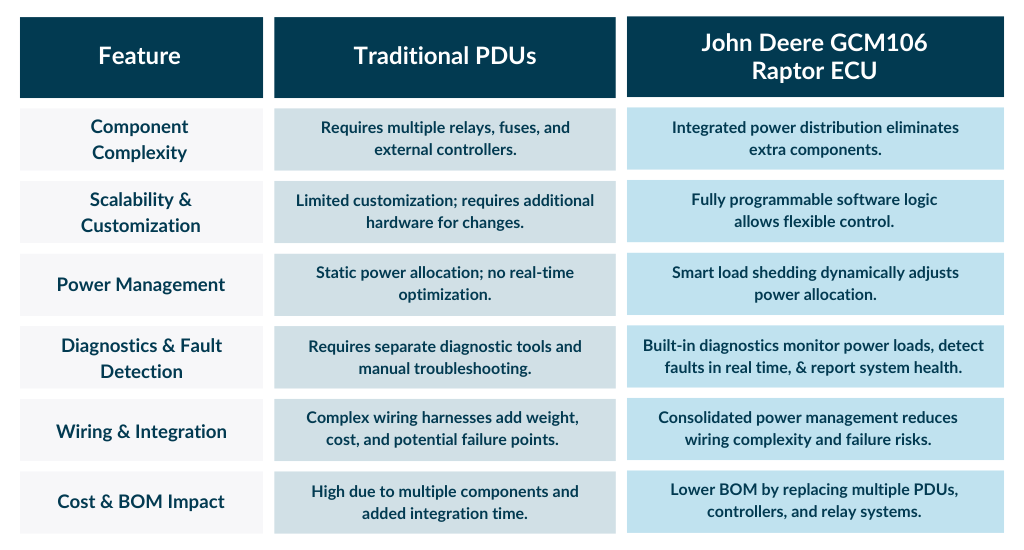The Challenge of Power Distribution in Modern Vehicles
OEMs in commercial, agricultural, and off-highway vehicle manufacturing face an ongoing challenge: managing power distribution efficiently while keeping BOM costs low and vehicle systems reliable.
Traditional Power Distribution Units (PDUs) have long been used to manage electrical loads across vehicle subsystems. However, as vehicle architectures grow more complex—with increasing electrification, advanced control systems, and new connectivity requirements—the limitations of standalone PDUs are becoming more apparent.
The GCM106 Raptor ECU from John Deere and New Eagle offers a smarter approach, integrating power distribution directly into an advanced ECU, eliminating the need for external relay boxes, multiple controllers, and complex wiring harnesses.
Traditional PDUs vs. GCM106 ECU: A Side-by-Side Comparison
Why OEMs Are Moving to Smarter Power Distribution
The shift away from traditional PDUs is driven by the increasing demand for simpler, more efficient, and cost-effective vehicle architectures. Here’s why manufacturers are embracing the GCM106 ECU for their next-generation designs:
1. Reduced BOM Costs & Manufacturing Complexity
- Traditional PDUs require multiple components (relays, fuses, wiring harnesses, control modules), increasing both unit costs and assembly labor.
- The GCM106 ECU consolidates these functions into a single, scalable unit, reducing the overall BOM cost while also minimizing supplier management complexity.
2. Smart Load Management Improves Efficiency
- Traditional PDUs lack real-time power optimization, leading to unnecessary energy consumption and inefficiencies.
- GCM106’s smart load shedding dynamically adjusts power distribution based on system demand, maximizing battery life in electric vehicles and reducing alternator load in conventional systems.
3. Built-In Diagnostics Reduce Downtime
- In a traditional system, diagnosing electrical issues requires manual troubleshooting and separate diagnostic tools, leading to downtime.
- The GCM106 ECU continuously monitors voltage, current, and power conditions, instantly reporting faults and allowing for faster, data-driven troubleshooting.
4. Simplified Wiring & Vehicle Integration
- A major drawback of traditional PDUs is complex wiring harnesses that increase installation time, vehicle weight, and failure points.
- The GCM106 ECU integrates multiple outputs and controls into a single embedded controller, reducing harness complexity and improving reliability.
5. Scalability Across Multiple Vehicle Models
- PDUs must be custom-built for each vehicle application, requiring different parts for different models.
- The GCM106 ECU is software-programmable, meaning OEMs can standardize one ECU across multiple vehicle platforms, reducing inventory and development time.
Real-World Impact: How an OEM Cut Costs with GCM106
One of our customers in the commercial EV industry replaced their traditional PDUs with the GCM106 ECU and saw:
- Significant reduction in wiring complexity
- Lower BOM costs by eliminating external relay modules
- Improved system reliability with built-in fault detection
The Future of Vehicle Power Distribution is Smarter
OEMs looking to reduce costs, improve system efficiency, and simplify vehicle architecture are transitioning away from traditional PDUs and relay-based power distribution.
The GCM106 ECU delivers a modern, integrated alternative, making it the smart choice for power distribution in commercial, agricultural, and off-highway vehicles.
Want to see how GCM106 can improve your vehicle’s power system? Request a consultation.




